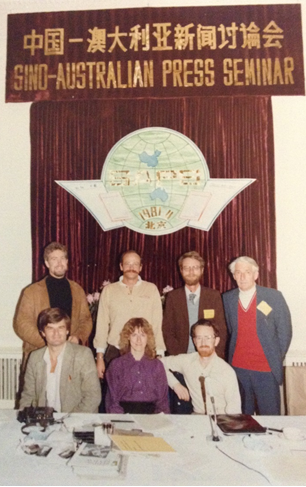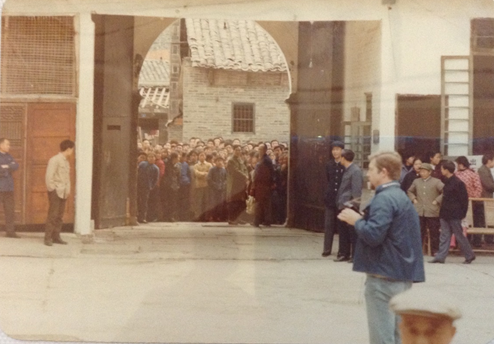Putting China's dramatic transformation into perspective
I have been to so many countries in the last decade that my carbon footprint is Yeti-size. But one country I haven’t been to for 32 years is the one I’m in now: China.
What a difference three decades makes: my visit in 1981-82 coincided with the trial of the Gang of Four; now many sub-25 Chinese think that must be the name of a new boy band they yet haven’t heard of.
My last visit was to run a seminar between Australian and Chinese journalists on behalf of the Australia-China Council, after which we did a tour that focused on the nascent attempts to transform the socialist and agrarian commune-oriented China of Mao’s day into a modern industrial country. Just before we left Australia, China released economic statistics that had everyone on the Australian side scratching their heads: it reported a 17 per cent increase in “light industry” output and an 8 per cent fall in “heavy industry”.
Figure 1: The Australian delegation for the seminar. I'm the thin bloke with the beard sitting down.

This just didn’t compute: to produce light industry output -- bicycles, cars, washing machines, computers -- you need heavy industry -- steel, chemicals, etc. How could one go up so much and the other go down?
Our attempts to answer this question -- and virtually every other -- was met with one answer: ‘We followed the directives of the Central Committee of the Communist Party of China.”
No one says that these days -- though the Central Committee is still there of course, and setting the objectives at the national level. But back then, that line was your defence in case anything went wrong: you were just following orders. Even though the great economic liberalisation of China had begun, it was still a totalitarian state. In a single party sense it is still, and central command is still powerful, but it is not the all-pervasive control it was back then.
Figure 2: The China of 1981/82. A village waited four hours to see these foreigners emerge from a feast at the local communist party headquarters.

At that time China had about one billion people, 30 million of whom were members of the Communist Party -- which I likened to having the Boy Scouts running the country, and also reporting on everything anyone said or did back to the Scout Masters. The Scout Masters themselves were divided -- the industry and market-focused “capitalist roaders” at one extreme, agrarian Maoists at the other -- but central direction was the rule for whichever faction was dominant. And imposing a central rule on such a huge country came down to issuing slogans.
The personal insurance policy of “following the directives” in turn meant that these instructions were interpreted absolutely literally -- which is what we ultimately realised solved our statistical puzzle when we met the Mayor of Shanghai, and another official whose title was literally translated as the “economic boss of Shanghai”.
We asked him to explain the heavy industry-light industry conudrum, and we got the stock answer: “We followed the directives …”. So someone in our group asked “Yes, and what was that?” He replied that the Central Committee had sent out a directive to “promote light industry”. “So what did you do,” another asked.
“We stripped heavy industry factories and turned them into light industry,” he explained.
Goodbye conundrum, but goodbye any chance of successful industrialisation if that was how China was going to go about it after Deng Xiaoping's reforms.
We also saw a commune in Sichuan that was converting from the self-sufficiency of the old Maoist days to the market of Deng’s. Their speciality was furniture, and the Communist officials proudly spoke of a 70 per cent increase in one year. The plan was to replicate this success across all the province of roughly 100 million people.
How did you sell all that, the Australian journalists asked? “We sent out propagandists”, came the translated reply.
Yeah. It turned out that state-owned furniture factories in Shanghai had been directed to buy the commune’s output. Easy for one commune, impossible for all. Strike two against a successful industrialisation program.
Finally we visited the newly declared Shenzhen Free Trade Zone. Free Trade Zones were nothing new at the time -- the first had been established in Ireland back in 1959 -- and their history in the Third World had been patchy: foreign companies would set up in one country to exploit low wages, only to move to another when wages rose substantially. But China had something else in mind with Shenzhen: Yes, foreign companies could take advantage of low wages (and low land and capital costs too), but there had to be a Chinese partner, and within seven years the partner had to own 50 per cent of the business (or something of that order -- I’m going on memory here).
So China was attempting not merely to provide work for its under-employed labour, but also to create a capitalist class -- and to get the latest Western technology in the bargain as well.
This sounded like a home run to us, and history has shown that it was. This new class was drawn largely (but not exclusively) from the ranks of the Communist Party itself of course, but China was truly transformed from a moribund centrally-planned economy into a vibrant capitalist one -- still with a single party in political control, but no longer trying to control everything centrally by slogan. Whatever capitalist crises may strike this nation in the near future, the incredible success of this transformation should not be forgotten.
Figure 3: The China of today














